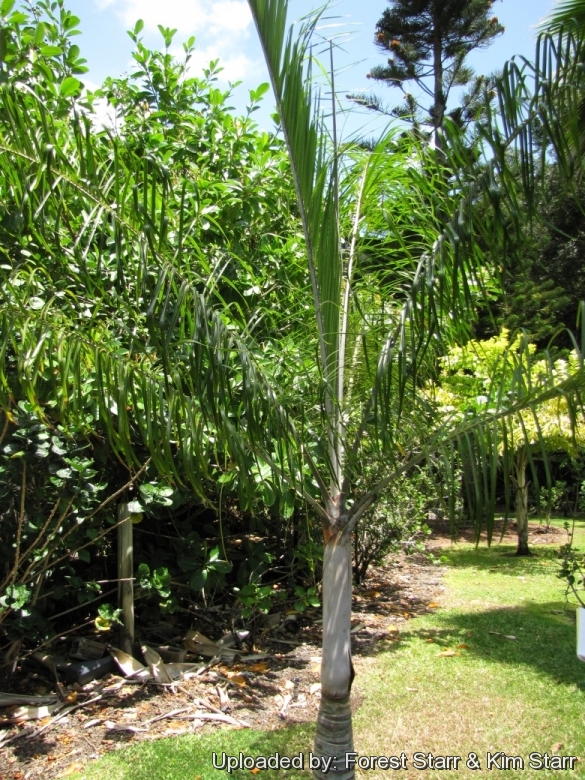
Habit at Iao Tropical Gardens of Maui, Maui, Hawaii (USA). May 22, 2012.
Origin and Habitat: Madagascar, endemic to a small in area south of the town of Ambositra.
Habitat: Open forest and remnant of riverine forest at high elevation between 1300-1500 m above sea level, in a rocky valley on the steep slopes of the high central plateaux of Madagascar. Central Madagascar can be quite a hostile environment, getting down to freezing in winter, and being very hot and dry in summer. This species is critically endangered in its native habitat, however it is becoming established in cultivation.
Synonyms:
Common Names include:
ENGLISH: Ambositra palm
Description: Dypsis ambositraeSN|24440]]SN|24440]] is a very attractive, medium sized, single trunked palm that occasionally produces one or two suckers. It has long thin, gracefully arching leaves, giving this palm an elegant silhouette. Many seedlings has come into horticulture under the name ambositrae but most have turned out to be seed of other Dypsis species.
Trunk: Up to about 7 metres tall, mostly solitary occasionally dividing dichotomously to form two stems.
Crownshaft: Beautiful chalky-white.
Leaves: Pinnate dark green leaflets. The juvenile of the species is highly colorful with red petioles and leaf rachis.
Bibliography: Major references and further lectures
1) Forest & Kim Starr Dypsis ambositrae (ambositra palm). Plants of Hawaii. <http://www.starrenvironmental.com>. Downloaded on 21 August 2014.
2) J. Dransfield and H. Beentje. “Palms of Madagascar” 1995
3) Don Ellison, Anthony Ellison “Cultivated Palms Of The World” UNSW Press, 01/May/2001
4) Robert Lee Riffle, Paul Craft “An Encyclopedia of Cultivated Palms” Timber Press, Portland 2007
5) John Dransfield, Natalie W. Uhl, Conny B. Asmussen, William J. Baker, Madeline M. Harley, Carl E. Lewis: “Genera Palmarum. The Evolution and Classification of Palms.” Royal Botanic Gardens, Kew 2008
6) Palmpedia contributors. "Dypsis ambositrae." Palmpedia, PALM ENCYCLOPEDIA, <http://www.palmpedia.net> Downloaded on 26 Aug. 2014
7) Jones, D. L. “Palms throughout the world.” 1994
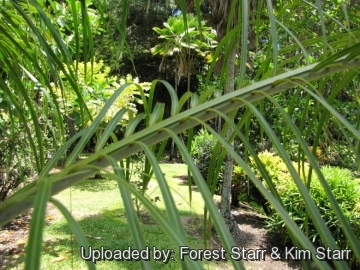 Leaves at Iao Tropical Gardens of Maui, Maui, Hawaii (USA). May 22, 2012. Photo by: Forest Starr & Kim Starr
Leaves at Iao Tropical Gardens of Maui, Maui, Hawaii (USA). May 22, 2012. Photo by: Forest Starr & Kim Starr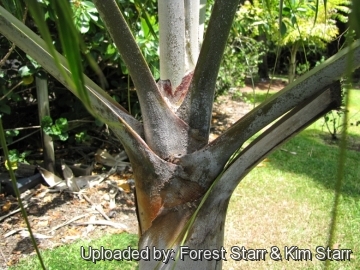 Axils at Iao Tropical Gardens of Maui, Maui, Hawaii (USA). May 22, 2012. Photo by: Forest Starr & Kim Starr
Axils at Iao Tropical Gardens of Maui, Maui, Hawaii (USA). May 22, 2012. Photo by: Forest Starr & Kim Starr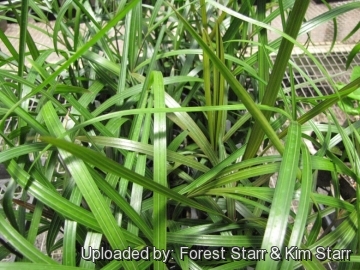 In pots at Iao Tropical Gardens of Maui, Maui, Hawaii (USA). May 22, 2012. Photo by: Forest Starr & Kim Starr
In pots at Iao Tropical Gardens of Maui, Maui, Hawaii (USA). May 22, 2012. Photo by: Forest Starr & Kim Starr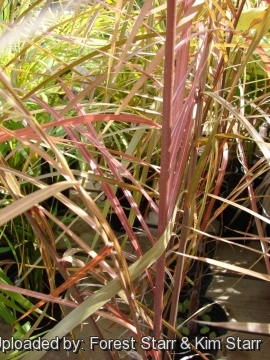 Habit at Home Depot Nursery Kahului, Maui, Hawaii (USA). January 17, 2008. Photo by: Forest Starr & Kim Starr
Habit at Home Depot Nursery Kahului, Maui, Hawaii (USA). January 17, 2008. Photo by: Forest Starr & Kim StarrCultivation and Propagation: This palm is an excellent relatively slow-growing garden plant adapt to different climates, from tropical to warm temperate, presumably it would quite a hardy plant in cultivation. It can tolerate sweltering heat and windy conditions.
Soil: It prefers well-drained sandy soil except those that are constantly soggy.
Light: Prefers full sun but will take some shade.
Drought tolerance: Moderate. This palm a will tolerate occasional dryness if not prolonged and can even thrives in poor, dry soils, but do better when grown in nutrient-rich soils with regular watering.
Fertilization: Need a perfect fertilizer diet including all micro nutrients and trace elements.
Aerosol salt tolerance: It is moderately salt tolerant, but does a lot better inland then it does on the coast.
Hardiness: Some cold tolerance. This palm has tolerated temperatures down to –1ºC and even a little snow (USDA Zone 9b-11). However it can be difficult to get it to look its best without a great amount of heat and sun.
Aerosol salt tolerance: It is moderately salt tolerant.
Maintenance: Remove dried fronds.
Remarks: The plant does not transplant well, having very sensitive roots that tend to die off if manipulated. If home-grown, give some sun as with most tropical palms, and water well and feed once monthly.
Use: Its very neat appearance and stature makes it perfect near highways and used to accent residential landscapes and close to swimming pools. It is sometimes closely planted in groups of two or three.
Disease & Pests: It is quite resistant to pests but may require regular fertilization to prevent yellowing caused by potassium deficiencies.
Propagation: Fresh seeds germinate quickly within a month of being planted and the seedlings are attractive.













